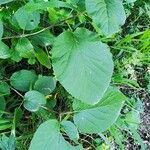Shrubs, deciduous, to 5 m tall. Bark gray-brownish. Branchlets of current year yellow-whitish or gray-whitish stellate-tomentose; branchlets of previous year gray-brownish, slightly quadrangular, glabrous, with dispersed, small, rounded lenticels. Winter buds naked, yellow-whitish or gray-whitish stellate-tomentose. Leaves always opposite, not clustered at apices of branchlets; stipules absent; petiole green, robust, 6-17 mm, yellow-whitish or gray-whitish stellate-tomentose; leaf blade greenish white when young, orbicular-ovate or shallowly cordate to ovate-lanceolate, 5-12 × 4-8.5 cm, papery, abaxially stellate-pubescent, adaxially densely stellate-pubescent, midvein raised abaxially, lateral veins 5-or 6-jugate, pinnate, arched, branched, ending in teeth, raised abaxially, slightly impressed adaxially, veinlets transverse, slightly raised or inconspicuous abaxially, inconspicuous adaxially, not lobed, base truncate, rounded to slightly cordate, without glands, margin remotely serrulate or subentire, apex acute to shortly acuminate, rarely obtuse to rounded. Flowers appearing with leaves; inflorescence a compound umbel-like cyme, terminal, 5-8 cm in diam.; rays whorled; first node of inflorescence usually with 5 rays, dense, yellow-whitish or gray-whitish stellate-tomentose, without large sterile radiant flowers; peduncle 1-3 cm, slightly sulcate; bracts caducous, leaflike, green, linear-lanceolate, stellate-pubescent; bracteoles scalelike. Flowers on rays of 2nd and 3rd orders, not fragrant; pedicel 2-3 mm. Calyx greenish; tube tubular-obconical, 3-4.5 mm, glabrous; lobes ovate-orbicular, very small, 0.5-1 mm, glabrous, apex obtuse. Corolla white, pinkish outside, funnelform-campanulate, glabrous; tube 5.5-6.5 mm, longer than lobes; lobes spreading, orbicular-ovate, 1-2 mm, shorter than tube, apex rounded, margin entire. Stamens shorter than corolla, inserted near base of corolla tube; filaments ca. 3 mm; anthers yellow, subglobose, ca. 1 mm. Styles taller than calyx lobes; stigmas capitate. Fruit black, oblong-ellipsoid, 8-12 × 5-6 mm, base rounded, apex rounded, glabrous; pyrenes ellipsoid to ovoid-oblong, 7-10 mm, with 2 shallow dorsal grooves and 3 ventral grooves, apex rounded. Fl. Apr-Jun, fr. Jul-Aug.
More
A large deciduous shrub. The stems are 2-3 m long. The young shoots and underneath the leaves are covered with white, woolly, star-shaped hairs. The leaves are 5-12 cm long and rounded. They can have blunt teeth. The flowers are in domed clusters at the top of the plant. They are white with a tinge of pink. The flower clusters can be 5-10 cm across. The flowers are 8 mm across. The fruit are red and turn black when ripe. They are 8-13 mm across. They are edible. They have one seed.

